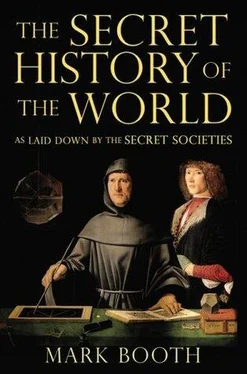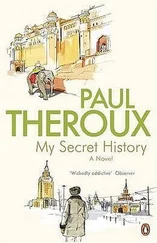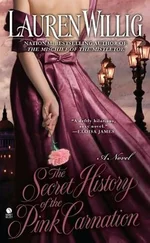Sancho Panza tied a rope a hundred fathoms long to his master’s doublet, then lowered him through the mouth of the cave, Don Quixote hacking his way through brambles, briars and fig trees, dislodging crows and rooks.
At the bottom of the cave the Don could not stop himself falling into a deep, deep sleep. He awoke to found himself in a beautiful meadow. But unlike in a dream he could think reasonably…
He approached a vast palace of crystal where he was met by a strange old man in a green satin hood, who introduced himself as Montesinos. This man, evidently the genius of the transparent palace, told him he had long been expected. He took the Don to a downstairs chamber and showed him a knight lying on a marble sepulchre. This knight had been bewitched by Merlin, Montesinos told him. Furthermore, he said, Merlin had prophesied that he, Don Quixote, would break the spell, and so would revive knight errantry…
Don Quixote returned to the surface and asked Sancho Panza how long he had been gone. Told not more than hour, Don Quixote said this could not be, that he had spent three days underground. He said he saw what he saw, touched what he touched.
You’re saying the most foolish things imaginable, said Sancho Panza.
The whole novel is a play on enchantment, illusion, disillusion — and a deeper level of enchantment. It reads like a series of parables in which the meaning is never explicitly stated and never quite clear. But the deepest level of meaning has to do with the role of imagination in forming the world. Don Quixote is not just a buffoon. He is somebody who has the strongest desire to have his innermost questions answered. He is being shown that material reality is just one of many layers of illusions, and that it is our deepest imaginings that form them. The implication is that if we can locate the secret source of our imaginings, we can control the flow of nature. By the end of the novel the Don has subtlely changed his surroundings.
We saw earlier that when we are in love we choose to see the good qualities in the one we love. We saw how our good-heartedness helps to bring out these qualities and make them stronger. The reverse is also true. Those we despise become despicable.
A similar choice confronts us when we contemplate the cosmos as a whole. Cervantes was writing at a turning point in history when people no longer knew for sure that the world is a spiritual place with goodness and meaning at its heart. What Cervantes is saying is that if, like Don Quixote, we good-heartedly decide to believe in the essential goodness of the world, despite the brickbats of fortune, despite the slapstick tendency in things that seems to contradict such spiritual beliefs and make them look foolish and absurd, then that decision to believe will help transform the world — and in a supernatural way, too.
Don Quixote is reckless in his good-heartedness. He takes an extreme and painful path. He has been called the Spanish Christ, and the effect of his journey on world history has been quite as great as if he had really lived.
CERVANTES DIED ON 23 APRIL 1616, the same date as Shakespeare.
The sparse traces left by William Shakespeare in the written records yield few definite facts. We know he was born in the village of Stratford-upon-Avon in 1564, that he was educated at the village school, became a butcher’s apprentice and was caught poaching. He left Stratford for London where he became a bit-part player in a company at one time under the patronage of Francis Bacon, and many successful plays were performed, the published versions of which bear his name. He died leaving his second best bed to his wife in his will.
His contemporary, the playwright Ben Jonson, said sneeringly of William Shakespeare that he knew ‘small Latin and less Greek’. How could such a man have created a body of work, saturated in all the erudition of the age?
Many great contemporaries have been pushed forward as the true author of Shakespeare’s plays, including his patron, the seventeenth Earl of Oxford, Christopher Marlowe (working on the theory that he wasn’t really murdered in 1593, just as the plays of Shakespeare began to appear), and latterly the poet John Donne. An American scholar, Margaret Demorest, has noted the strange links between Donne and Shakespeare, the likeness of their portraits, the similarity in nicknames, ‘Johannes factotum’ for Shakespeare and ‘Johannes Factus’ for Donne, odd idiosyncrasies in spelling — both use cherubin for cherubim, for example — and the fact that Donne’s publications begin when Shakespeare’s cease.
But the most popular candidate is, of course, Francis Bacon.
An infant prodigy, Francis Bacon was born into a family of courtiers in 1561. At the age of twelve a masque he had written, The Birth of Merlin , was performed before Queen Elizabeth I, who knew him affectionately as her little Lord Keeper. He was a small, weak, sickly child and his schoolfellows teased him by calling him by a pun on his name, Hamlet, or ‘little ham’. He was educated at Oxford and when, despite the Queen’s earlier fondness for him, he was blocked again and again in his political ambitions, he conceived an ambition to build himself an ‘Empire of learning’, conquering every branch of erudition known to man. His intellectual brilliance was such that he became known as the ‘wonder of the ages’. He wrote books that dominated the intellectual life of his day, including The Advancement of Learning , the Novum Organon , in which he proposed a radical new approach to scientific thinking, and The New Atlantis , a vision of a new world order. Part inspired by Plato’s vision of Atlantis, this would prove very influential on esoteric groups in the modern world. When James I came to the throne Bacon quickly achieved his long-held ambition and became Lord Chancellor, the second most powerful post in the land. One of Bacon’s responsibilities was the distribution of land grants in the New World.
Bacon’s brilliance was such that it seemed to cover the whole world, and, all other things being equal, he might seem to be a better candidate for the author of the plays of Shakespeare than Shakespeare himself.
Bacon was a member of a secret society called the Order of the Helmet. In The Advancement of Learning , he wrote of a tradition of handing down parables in a chain of succession and with them hidden meanings on the ‘secrets of the sciences’. He admitted he was fascinated by secret codes and numerological ciphers. In the 1623 edition of The Advancement of Learning he explained what he calls the Bilateral Cipher — which would later become the basis of the Morse Code.
It is interesting to note that his favourite code was the ancient ‘cabalistic cipher’ in terms of which the name ‘Bacon’ has the numerical value thirty-three. Using this same cipher, the phrase ‘Fra Rosi Crosse’ can be founded encoded on the frontispiece, dedication page and other significant pages in The Advancement of Learning .
And using the same cipher, the same Rosicrucian phrase can also be found in the dedication in the Shakespeare Folio, on the first page of The Tempest and on the Shakespeare monument in Stratford-upon-Avon. The rolled scroll on the Shakespeare Memorial in Westminster Abbey also has it, together with the number thirty-three, which we have just seen is the number for Bacon.
IN ORDER TO UNDERSTAND THE SOLUTION to this mystery given in the secret history, it is necessary first to take a look at the work.
The plays of Shakespeare play with altered states, with the madness of love. Hamlet and Ophelia are descended from the Troubadours. There are wise fools — like Feste in Twelfth Night. In Lear’s Fool, the Christ-like jester who tells the truth when no one else dares, the fool of the Troubadors achieves apotheosis.
Читать дальше












